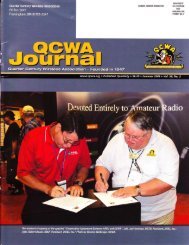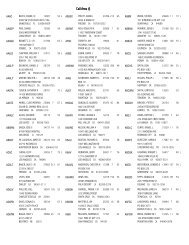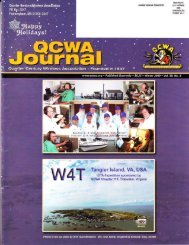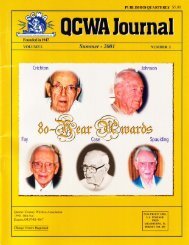Untitled - Quarter Century Wireless Association
Untitled - Quarter Century Wireless Association
Untitled - Quarter Century Wireless Association
You also want an ePaper? Increase the reach of your titles
YUMPU automatically turns print PDFs into web optimized ePapers that Google loves.
Later that afternoon we headed back to Havana. We<br />
arrived at the group house around 8:30 PM.<br />
I was immediately met by Amie, who told me that he and I<br />
needed to proceed at once to the headquarters of the Federacion<br />
Radioafectionados, de Cuba, (FRC) the national ham radio<br />
organization, because the presentations I was to make were going to<br />
be filrne.d for later airing on national television!<br />
We arranged for one of the drivers to take us to the<br />
headquarters so I oould made my presentations. I was accompanied<br />
by Lynn Mims, one of the Methodist ministers who agreed to do the<br />
photography work so that I could have pictures ofthe occasion.<br />
In my capacity of an ARRL Offrcial, I met with Ing. pedro<br />
Rodriguez, CO2RP, the president of FRC, and presented him with a<br />
certificate commemorating the FRC's participation in the past June<br />
VIilr QSO Party through the DXpedition of COOFRC at<br />
Bellomonte. I also presented Arnie with an Author's Certificate for<br />
his article in December 1993 QST. These presentations were<br />
videotaped by a film crew from the national TV network.<br />
Later, I participated in lively and fruitful discussions with<br />
Pedro, Francisco Hemandez, CO2IIA, FRC Vice-President, Giraldo<br />
Uffo, CO2UF, FRC Secretary General, Oscar Morales, Jr., CO2OJ,<br />
FRC Chairman of the VHFAJI{F/S}IF Committee, and Eddy Frank,<br />
CO2EG, one of the members of the board of directors of the FRC<br />
conceming ham radio in Cuba today<br />
At one point our discussion was intemrpted by a Cuba<br />
Channel 2 news team who wanted to interview me for their evaning<br />
news. The r€porter asked me why I was in Cuba and my first words<br />
were that I was there as part of a Methodist Chruch sponsored team<br />
to work on rebuilding a church in Cifuentes. In effect, I was telling<br />
the whole country that I was an American who was there<br />
representing religious freedom and that I was putting actions into<br />
my words by working alongside Cubans in achieving that goal.<br />
(Ihe importance of this episode on the trip did not fully<br />
surface until I retumed home. A few days after my retum, I talked<br />
with Arnie over the air. I asked him about the airing of my interview<br />
and he told me that the reporter aired my remarks about the<br />
Methodist church uncut and even added some positive words of her<br />
own in the introduction of her tape. He also told me that the<br />
interview aired three times on national TV. To this day I wonder if<br />
the people in Cifirentes saw it and got to hear the name of their town<br />
being spoken of in connection with religious freedom. I am almost<br />
certain that they did.)<br />
Following the interview, I read the "And Finally..." article<br />
that appeared in the last Journal to the members of the media who<br />
were covering the activities. After this reading, the FRC leaders held<br />
a publio reception honoring my presence at their headquarters.<br />
Following that reception, complete witl homemade goodies, we<br />
resumed our discussions.<br />
During the course of the oonversation I told them all about<br />
the teamwork in Cifuentes and that was the principle reason for my<br />
trip.<br />
Among the ham radio items discussed were future Cuban<br />
proposed ohanges that would create a no oode type class of license<br />
authorizing these licensees very low power acc€ss to 160 meters,<br />
authorizing the present Novice type class licensee access to l0<br />
meters (with 50 watts of power), and increased frequency<br />
authorizations on VHF and UIIF bands.<br />
With regard to the last item, because their VHFAJHF<br />
frequency allocations are modeled after the IARU region I band<br />
QCWA Jorunal<br />
plans, allocations of amateur radio frequencies are similarly<br />
modeled.<br />
For example, they only have the bottom 2 Nfrlz of the 2<br />
meter ham band (same as Europe). Their primary FM repeater pair<br />
is on 145.600, the same as the R0 channel in Europe. They pointed<br />
out to me that they have had access to the 2 meter ham band only<br />
since 1987.<br />
It was interesting to note that, while not ha"ing access to<br />
the latest repeater directory or direct contact with south Florida<br />
repea.ter coordinators, they develo@ a defacto plan of cooperation<br />
with south Florida by monitoring the frequencies of &equently heard<br />
repeaters and avoiding them.<br />
With regard to the 135 cm ham band, over time they have<br />
gained piecemeal access to it. However, their frequency allocation<br />
presently starts at around 223 l\filzl They assured me, however, that<br />
they are working to acquire a portion of the band that would be<br />
cornmon to USA weak signal operations. In that light, I provided<br />
thern with the weak signal calling frequency for that band, as well as<br />
all the VHF USA ham bands.<br />
Regarding the 70 cm ham band, they have gained a<br />
window around 435 MIIZ for access to amateur satellite uplink and<br />
a window around 432.100 MlIz for access to weak signal operation,<br />
but only with anterura elevation in excess of l5o. However, they<br />
have requested and have been assr.ued that they will receive acrcess<br />
to that window with no elevation restrictions in the near fuhre.<br />
They explained that the time required for the transition is<br />
necessitated to accommodate other services' moving off the<br />
requested ham frequencies. This, they said, will take some time<br />
because some of the radios of the other seryices are crystal<br />
controlled and such crystals are not readily available.<br />
They also told me of the plans to develop radio clubs and<br />
that would encourage the growth of the Novice class of license by<br />
authorizing the supervised use of these club stations by nonlicensees<br />
who are apprenticing to become hams.<br />
A major item discussed was the proposal of a joint Cuba-<br />
USA team to operate a contest station during the ARRL June VHF<br />
QSO Party from Bellomonte, possibly with a special rare prefix call<br />
sign. Suggestions were made that possible special permits would be<br />
issued for Cuban operation on various microwave bands not<br />
currently available to them. Two of the bands discussed in particular<br />
were 135 and 33 cm.<br />
I was invited to head a team of U.S. hams. I accepted<br />
conditionally upon clearance of all the govemment hurdles. I have<br />
been tluough that route before!<br />
I also hand delivered a letter from a leader of a team of<br />
U.S. operators suggesting an exchange of ham radio operators<br />
similar to the USIA joint Soviet, USA exohange and suggesting a<br />
joint USA-Cuba FIF contest operation in Cuba during the 1995 CQ<br />
WPX Phone contest. They said that they would seriously consider<br />
such an operation.<br />
We carried on discussing other items (including the touohy<br />
subject of deliberate interference to intemal traffrc nets from stations<br />
in south Florida) for a total of nearly two hor-us util we just had to<br />
leave in order for the building to be secured.<br />
All of us concluded that we had oovered a great deal of<br />
ground in furthering the hobby of ham radio and the relationships<br />
between the hams of our two countries.<br />
After the events of the wening wound down and we were<br />
on our way to Amie's home for a little visit I wondered how I could<br />
have gotten ttrough the evening as ill as I was the night before.<br />
24


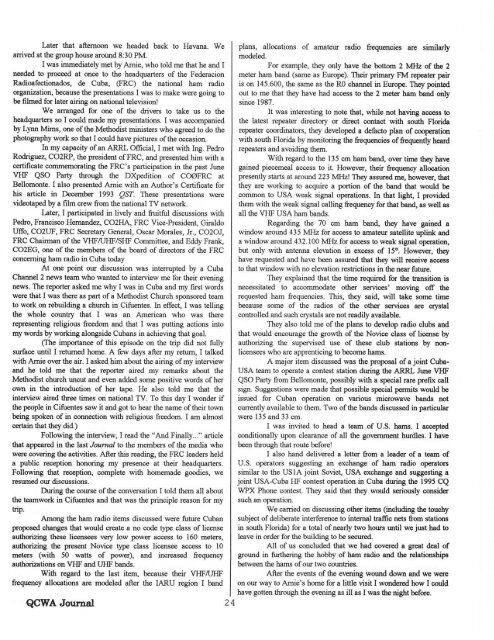
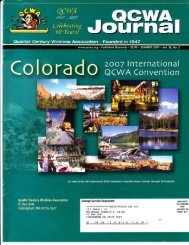
![11{J hI EfifSIt]E I]E - Quarter Century Wireless Association](https://img.yumpu.com/11816560/1/190x245/11j-hi-efifsite-ie-quarter-century-wireless-association.jpg?quality=85)
